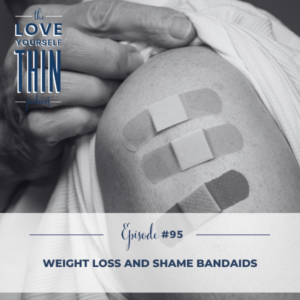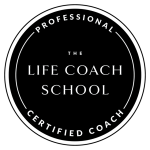
Do you immediately jump to shame when people make negative comments about you, your relationships or your family? Well guess what? Shame is an optional emotion and we can choose to think something else when moments of shame arise in our lives.
In today’s episode, I talk about how to get out of using shame as a bandaid for your life and relationships. By reframing our thoughts and focusing on more positive or constructive perspectives, we can minimize the impact of shame and prevent it from controlling our actions and decisions.
If you are ready to lose weight and change the way you think about hunger, sign up for the lifetime access membership for Love Yourself Thin! Doors are open and you can find all the information by clicking here.
What You’ll Learn from this Episode:
What is a shame band aid
We can choose to feel something other than shame
Clean vs. dirty pain
- Shame keeps you in a victim mentality
Listen to the Full Episode:
Featured on the Show:
- If you are ready to lose weight and change the way you think, sign up for the lifetime access membership for Love Yourself Thin! Doors are open and you can find all the information by clicking here.
- Leave me a review in Apple
- Jody Moore: Clean Pain vs. Dirty Pain
Full Episode Transcript:
95. Weight Loss and Shame Bandaids
Your mom comes over and makes a comment about how you didn’t dust or keep your house very well, or a friend comments on how your piecing isn’t quite there yet, or your husband expresses that having leftovers three days in a row is irritating. What about when your neighbor asks you when you’re going to get a professional landscaper to come and do some work, or when you step on a scale? These are all triggers that might be contributing to a shame bandaid, which is keeping you from losing weight and keeping it off for good. My name is Dara Tomasson and this is Love Yourself Thin episode 95, Weight Loss and Shame Bandaids.
Hello everybody. Shame bandaids. This is a concept that I have created in my coaching because I see this happening a lot, not only for my clients, but I probably have suffered from shame bandaids for most my life, and didn’t even realize that I was, and it wasn’t until I was able to have my own coach help me work through some struggles that I had, then I started to see it in my clients and now it is something I teach inside Love Yourself Thin. So since it was such a huge revelation to me and it was something that I was doing subconsciously, Yeah, I would say since I was eight years old. I’m really excited for you to listen to this podcast. It’s amazing that we can go there and we can talk about this. So I, I definitely encourage you to print off the worksheets and if you need to get the worksheets, all you need to do is there’s a link there and you can get it. But to do this work, because I have a feeling that a lot of you are struggling with this. And you don’t even know it. It’s kind of like I was.
All right, so before I get into the shame bandaid. I’m just gonna share a quick win in my group because they’re just so fun to share. So this win is for one of my clients and we talk about a sandwich generation. She took her six and eight year old granddaughters on an airplane to visit her 91 year old mother. And she was able to do all of that with all of the complexities of caring for her mom and her granddaughters, and making sure everyone was entertained and everyone was having a good time. And not only did she do that, but she was able to do it and not gain weight. And even right before she left, her husband wasn’t feeling well, and so she was, kind of fighting off this cold that she had, was given from her husband, and so she was able to do all of that because she’s able to use the mind tools and when triggers come she’s able to handle them.
So let me break down this podcast for you, and so you can understand where I’m coming from and what I’m actually talking about because I made this term up. And so the definition of a shame bandaid is when you immediately go to shame instead of figuring out what you are really feeling. So how this came up for me is I have a manual, which means when you think about like an instruction manual, so I have an operating manual of what a daughter should look like and what a Christian should look like, what a Canadian should look like. We all have these ideas of what we’re supposed to be and then if we don’t follow what we think we’re supposed to be, then we go right to shame. And the funny thing about this is we don’t even realize that it’s an option to not feel shame.
So I’m going to repeat these triggers. I’m gonna kind of walk you through what I mean. So the first one was your mom comes over and makes a comment about how you didn’t dust or keep your house up very well. And so when I’m talking about a shame bandaid, it’s you saying, I’m terrible, I’m awful, I’m not good. There’s something about me that’s not good that I am deficient. And so you feel really shameful. And the problem is there are a lot of other feelings that come before that because you have to have those thoughts of judgment before you can feel shame. So there are other ways you can look at it. You could say if your mom comes over and she makes this comment about how you didn’t dust or you not keeping your house up very well, you could feel irritated, you could feel judged, you could feel mad, you could feel aloof. You could kind of laugh and say, yeah, I don’t, I don’t have that same level of cleanliness that you do.
So the next one, a friend comments on how you’re piecing isn’t quite there yet. So instead of going to shame of I’m not good enough, you could go to who do you think you are? So you could be incensed, you could be annoyed, you could feel disappointed that your friend would look at the negative. You could feel unempowered. There’s lots of different options of what you could feel that I don’t know necessarily if shame is the first one. Your husband expresses that having leftovers three days in a row is irritating. You could agree with him. You could say, yeah, it is irritating, or you could say, I just need to simplify my life. Like there are so many options of ways to think or to feel that you don’t have to go to shame, but if you have a manual that a good wife is supposed to provide variety of meals and have her husband happy all the time, then that’s when you can go to the shame of, I guess I’m not doing it good enough.
Your neighbor asks when you’re going to get a landscaper to come in and do some work, so you can go to, she doesn’t think I’m doing a good enough job myself, or she doesn’t approve of me, or the neighborhood doesn’t like me. So there’s lots of thoughts that create shame, but there’s also lots of other thoughts that are also optional. The neighbor said words. What do I want to think of the words my neighbor says? You stepping on a scale. You could feel curious, you could feel informed, you could feel empowered, you could feel all sorts of options, but you don’t have to go directly to shame. Now, the problem with shame is it takes you out of your own power. It goes to immediately of, I’m not good enough, and it doesn’t allow you the opportunity to take a pause and say to yourself, What do I want to feel in this moment? What would feel more interesting? What actually would reflect my true thought here? And so, just like with my clients with weight loss, when they understand that weight loss science is simple, what starts happening is they take a pause before they eat the chocolate bar or they eat the snack, or they eat whatever it is because they think to themselves, okay, I know what actually happens inside my body when I eat this, so do I want to choose to do this or not? And when they make that choice then they have that power.
So there’s two things I wanna really focus on in today’s episode. The first one I wanna focus on is this manual that we have. So one of the things that I find as a Christian and that I’ve struggled with ever since I was a little kid, I struggled with, you know, if God loves me, you know, and I have this opportunity to be on the earth and I have this body, I would feel shame about feeling upset about something. I thought, well, if I’m a good Christian girl, if I really showed appreciation to God, I shouldn’t be angry with my brother who’s making fun of me. I should just be grateful. So, because I had this thought of what a good Christian girl looks like, I didn’t allow myself to have the emotions that comes from having all sorts of emotions. The thing that I don’t realize and don’t plan on is that God gave us all sorts of emotions. So, but if I’m denying them and saying that they’re not good enough or I’m not being good, then I go straight to shame and I don’t give myself the opportunity to look at what’s really going on.
Another example, so with it being a daughter, so if you have a manual of what a good daughter should look like, and then you feel things like annoyed or resentful or upset or disappointed, then you’re not allowing yourself to have the full experience of being a daughter, and you’re not allowing yourself to really look at what’s going on. And so once you just keep slapping on that shame bandaid, is that what you’re starting to do is you really are starting to put yourself into a victim mentality because you think, no matter what I do, I’m never gonna be good enough. I’m never gonna figure this out, and this is a disaster.
So, I’m curious about what thoughts are coming for you. So I want you to think about your relationship with family or friends. If you have problems with your mom, you go to shame because you berate yourself or feeling a certain thing. I want you to start just letting yourself be embarrassed or frustrated or confused. I want you to be a human. Now in back in 2018 when I started learning about life coaching, I was learning all these tools from life coaching, and I remember this concept from Jodi Moore and I’m actually gonna read it right from her website and it’s called, is Your Pain Clean or Dirty? And this idea of clean and dirty pain is, really, really helpful. So I’m just gonna read it right from her website and we’ll link it in here in the show notes. So she explains it. Clean pain is part of life. It is necessary. It helps us grow and heal. Allowing it is important. Resisting it hurts worse than pain itself.
So here’s some examples. It’s the deep sadness you feel after losing a loved one. It’s the hurt you feel after being betrayed. It’s the fear you feel upon losing a job. It’s the disappointment you feel when your plans don’t work out. Clean pain almost feels good because it’s so cleansing. I think about my Grandma Hazel, when I look at her pictures, I feel this sadness, but it feels so genuine to me because it means that my relationship with her was so deep and it was so healthy and so for me to miss her, it does feel wonderful cuz I know that I loved her and that we, she had such a impact on my life. I recommend you name the emotions and then connect them to thoughts and allow them to wash over you. Depending on how extreme the event is that triggered it, you may need to allow them for a long time, but they will wash over you like a wave over and over getting smaller each time until you’re healed. For example. Hello sadness. I see you. I feel you. You are dark and heavy and slow. I know you’re here because of the unexpected loss of my mother, I am mourning her presence in my life and it feels good to mourn her. I need to feel sad right now. I want to feel sad so you can stay. I’m going to allow you here for a while.
Now if we go into dirty pain, dirty pain is created by your mind. It is not necessary. It does not help. It stops your mind from finding solutions and instead points it in the direction of finding evidence that something is wrong with you, with someone else or with your life or with the world. It is created by thoughts such as, I will never be happy now that my best friend is gone. I am so stupid for not realizing I was being taken advantage of. I am a horrible person for making that mistake. I’m worried about what could go wrong in the future. Dirty pain is minimized by allowing yourself to truly feel clean pain, but all of us create at least some dirty pain, and the majority of the pain we feel in life is dirty pain. I recommend you notice it. Notice yourself allowing thoughts that are creating it. Then question those thoughts. Are they really true? Are they absolutely, positively true all the time, or are they actually not true at all? Could the opposite be true even? And then Jodi goes on to say, the coaching I do with clients helps them identify the difference when it comes. When it’s someone’s else’s dirty pain it’s very easy to see that they are creating it. But when it’s your own, we have blinders that can make it nearly impossible to see the difference. So we need to learn to let go of the dirty pain. There is no room for it in life and no need for it either.
So when you think about this description, I want you to think about your shame bandaid. One of the things that happens when you go straight to shame is that it’s almost like you take yourself off the hook and it almost is like you’re saying, yeah, I know I’m not good. So, for example when your mom comes to your house and says, oh yeah, this house is kind of messy, like, when’s the last time you dusted? Or like, who’s in charge of sweeping? Because that piece of paper’s been on the floor for a week. When she makes those comments, the most beautiful thing is that’s a circumstance. She’s saying words and then the option, and we talked about this in a recent podcast about people’s words are almost like the, at the airport when they look through your bag like the x-ray, and so you can see all the thoughts and you can see, hmm, which ones are good for me and which ones aren’t. But when you go to shame, it’s like you don’t have to do any of that work. It’s like you’re telling yourself, yep see, I told you, not good enough, proved it, and then you don’t have to go to work to change anything. And then you can still stay in victim mentality and still feel like things are terrible and awful.
And so not going to the shame band-Aid actually means that it requires a little bit more work. And you’re gonna have to take that pause and make some decisions on, hey, what kind of person do I wanna be and how do I want to think? So the next time your mom comes over and makes a comment about your house being dusty, you then can say things like, yeah, it’s kind of dusty. If you wanna clean it, go for it. In fact, I have this funny example at church. There is a, a lady there, she’s probably in her early eighties, and she was making a comment about my son. So in our church, the young men, they pass the bread and water every Sunday and my son is very tall and he stands out quite a bit. You can’t miss him. And she doesn’t know me very well, and she said, oh yeah, that’s your son. Oh, he’s very, he’s very tall. He’s very strong, she says, but he can’t wear a shirt that’s not wrinkled to save his life. Something like that. So she makes this comment about my son wearing a wrinkly shirt. And within two seconds I said, well, if you wanna come over and iron shirt’s at my house, no problem. You can come anytime. And she kind of, she kind of realized what she had said and she’s taken back a little bit and I just said, yeah, if you wanna come and iron, no problem. It was really interesting and I didn’t allow myself to go to shame. I just thought that’s funny that that’s really important to her. And I can just decide if I wanna be offended by that or not. And then I promptly did fix his suit pants so he could wear his suit coat again. So then we would take that stress away from her. Cuz I think she really worries about him wearing a wrinkly shirt, which also, in my opinion, the shirts that he wears weren’t really that wrinkly. So it’s all relative.
And then if your friend makes a comment on your piecing isn’t quite there yet, there’s so many different options of how you wanna respond. You could say, yeah, my piecing isn’t there yet, and I will never, probably ever be someone that pieces that precisely. It’s just not my thing. Your husband expressing that having leftovers three days in a row is irritating. This is one of my favorite things, when my husband starts, if he says something about the house not being as clean or the laundry or something, I said, yeah, it’s a bummer. It’s a bummer that no one just comes in the cleaning house fairy or the cooking fairy. She doesn’t come all the time. It’s a bummer. And then I just diffuse it. And I don’t have to feel shame ever. I can just, that’s his opinion. And I can have mine. The neighbor asking about if the landscaper’s gonna come, that’s on her. And we could, we could, or him, we could ask all sorts of questions or we could just say, yeah, I don’t know if that’s ever gonna happen.
And then stepping on the scale. Now, this is something that I coach on all the time and one of the, the most beautiful options when you stand on the scale and you look at that number and if it’s higher than you want it to be, my favorite way of looking at it is to be able to say to yourself, what’s going on, girl? Why are you eating more than your body needs? Why are you buffering this way? Why aren’t you allowing yourself to feel feelings? Why aren’t you doing the work of feeling the feelings instead of eating them and trying to shove them down. And you say it with so much love and compassion and you’re able to start solving for those things that are really stressful in your life and it’s telling you that you’re worth spending time on. So how do we overcome the shame bandaid? And the question I have in the worksheet is, how are you going to get out of using shame as a bandaid for your life and relationships? How are you gonna start creating, having that responsibility for yourself and your emotions?
I have the five pillars for permanent weight loss. The first one is weight loss science is simple. So you learn about how to balance those four hormones that are required. The second one is to create your own eating plan and learn how to troubleshoot it. So if the number goes up on the scale, you’re able to look at, okay, what did I eat? How did I sleep? All of those questions. And then you’re able to really take ownership of all of that. Then the next pillar is that you get to feel your feelings instead of eating your feelings, and that is going to make a huge difference for you. The fourth pillar is to learn how to take responsibility for yourself. So when people say words to you, you get to choose what and how you’re gonna react to that. And then the fifth pillar is learning how to build self-confidence. And the first step of that is learning to trust yourself, being able to feel any emotion and then being able to really build that relationship with yourself.
So that is what I wanted to share, this concept of the shame bandaid. It was a huge revelation to me when I really got at this awareness, of I need to clean up the manuals that I have and really look at the life that I really want to have. It’s so amazing. This is where you get freedom. When you finally let yourself get into your brain, when you let yourself finally look at what’s really going on and stop living a life of autopilot, it’s when you get all your power back. It’s so, so exciting. All right. I really hope this episode has helped you and it’s been so much fun for me to prepare it for you. Take care.






